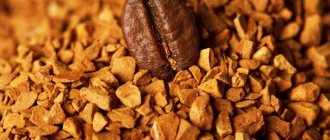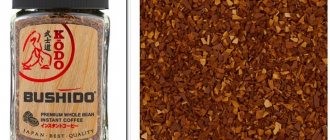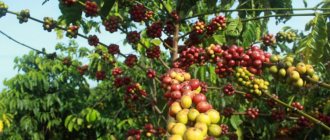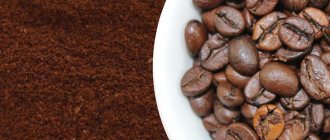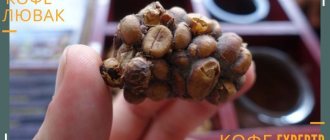What is Arabica
The designation on the can—Arabica coffee—is involuntarily associated with the name of the drink. However, this is not quite true. What is Arabica? In fact, it is a type of coffee tree, from the beans of which many types of coffee are produced. But we are more accustomed to calling all variations on the theme of this drink this way. The tree blooms with white flowers that open in the axils of the leaves. They say that the flowering period is an incredible beauty. But no one really saw it. It is impossible to catch flowering, because after 2 days everything falls off and fruits begin to set. This takes 9 months. The green color of the fruit gradually gives way to red. The pulp becomes juicy. Many local inhabitants of the animal world love to feast on the fruits of the coffee tree.
The most valuable varieties of Arabica coffee
Brazil has been considered the world leader in coffee production and the largest exporter of Arabica coffee for many years. It is inferior in volume to Vietnam, Colombia, Guatemala and Venezuela, but nevertheless has sufficient weight in the global economy.
These countries grow both well-known varieties of Arabica coffee and rare ones. The characteristics of the soil, climate, harvest time, and method affect the taste of the finished product, and in different countries all the indicators are different. The most popular Arabica varieties include:
- bourbon - collected from young trees, old plants will no longer give the same aroma and richness of the drink, premium class variety
- bourbon santos - this type is collected from old trees, designed for wide consumption at low prices
- maragojip - average grain quality, but the difference is in its size, larger than that of its counterparts
- blue mountain typica - grows in Jamaica, the name comes from its color, knowledgeable people prefer this expensive variety because of the unique taste
- Sumatra - strong taste and astringency give the drink a special charm, excellent long aftertaste
- Ethiopia Sidamo - the taste of coffee is softer than usual, Ethiopian lands contribute to such qualities of the drink
- Peru Supremo is an environmentally friendly type of coffee, characterized by tropical notes in taste.
- mocha Yemen - this taste is dominated by the aroma of chocolate with a subtle trail of bitterness
- Colombia excelsa - the taste of excelsa itself is balanced, the proportion of taste and aroma does not predominate over each other
- Hawaii Kona - nutty-almond delight with a slight sourness
Arabica coffee tree
The evergreen tree of the madder family is called Coffea Arabica. The plant reaches 10 meters in height in its natural environment. But it is not allowed to grow to such a state, otherwise harvesting the fruits will be labor-intensive and time-consuming, which will not affect the cost of the finished product for the better.
How did Arabica appear? Africa is the birthplace of the coffee tree and Arabica coffee. The shepherd was the first to notice the effect of the red berries. Goats that ate them were characterized by increased activity and endurance. The shepherd shared his observation with the abbot of the monastery. Thus, coffee berries became the diet of monks during long hours of prayer.
The appearance of the coffee tree is associated with cross-pollination of the small Eugenioides bush with Robusta, which already existed at that time. The small tree with the lowest caffeine content, Eugenioides, has many similarities to other coffee trees in terms of growth and fruit ripening. Therefore, it became the parent of a new species.
Chemical composition and nutritional value of Arabica
The Arabica variety has become the basis for most modern coffee varieties.
The chemical composition of coffee depends on the variety, so some indicators indicate a “fork” of data, that is, an interval, or an average value.
When fresh, 100 grams of coffee beans contain:
- caffeine: 0.6 – 2.7%;
- about 12% fat;
- 13% proteins;
- 8% sugar.
After heat treatment (roasting), the composition of coffee changes:
- caffeine level does not exceed 1.3%;
- 20% proteins;
- up to 15% fat;
- the sugar content is reduced to 2–3%.
In addition, roasted Arabica beans contain vitamins PP and pyridine, phenolic compounds. The calorie content of brewed coffee is 2 kcal.
The best roast for beans is medium.
How do these numbers affect the taste?
Arabica is about softness, unlike its “brother,” robusta. This is due to the lower caffeine content in the beans, because caffeine is what gives coffee its bitterness. Robusta contains twice as much – 2.7% in roasted beans. In addition, Arabica contains twice as much sugar as Robusta, which is why we find it so pleasant and sweet.
The Arabica variety in coffee is like the Merlot variety in wines, a true and win-win classic. Coffee made from Arabica beans has an intense, complex aroma that can be reminiscent of flowers, fruits, honey, chocolate or caramel. And always with a subtle sourness.
Where did Arabica originate?
Geographically, the Arabica tree appeared in territories that historically belonged to Kenya, Sudan and Ethiopia. But the Ethiopians were the first to eat fruits in raw and boiled form. As trade relations with the Arabian Peninsula developed, coffee trees began to be grown there. In turn, the Arab world discovered the coffee drink thanks to the inhabitants of Arabia, so it began to be called Arabian. This is not entirely correct, since Africa is the ancestor. But centuries later it is difficult to change anything. Therefore, the second name of the drink is still used in everyday life - Arabian coffee.
Seven types of Arabica, six of which you most likely have never even tried
Many people still believe that high-quality and tasty coffee should contain 100% Arabica. But, firstly, the best blends are considered to be mixtures of Arabica and Robusta, and secondly, not all the Arabica that you are used to seeing in stores. More precisely, there are more than three hundred types of Arabica coffee in the world alone, if we take into account natural mutations and hybrid plants with other types of coffee.
We will talk about the seven main ones in this article.
Typika
As the name suggests, it is the most “typical” representative of the family, the ancestor of many modern varieties. Typica was “born” in Ethiopia, from there it came to Yemen, and from Yemen it spread along with travelers throughout the world. Typica reacts poorly to coffee rust, is demanding on the soil and produces a small harvest, but the natural sweetness of the resulting drink makes up for it. Typica is the “mother” of such varieties as Maragogyp, Blue Mountain, etc.
Drinks from different types of typica are distinguished by a common feature: natural sweetness and lack of bitterness.
But they can differ in chocolate and floral notes, and a slight wine flavor.
Bourbon
The second most popular variety of Arabica. Bourbon, strictly speaking, is a natural mutation of typica. It was first noticed by coffee farmers on the island of Bourbon (now Reunion). Outwardly, the changes looked simple: the reddish upper leaves of the typica turned green, and the coffee beans acquired a more round shape. Over time, the appearance of the trees themselves has changed.
Bourbon is also very susceptible to coffee diseases, but, unlike Typica, it produces a larger yield. The species has the same natural sweetness and tenderness. Among the “descendants” of bourbon are such varieties as Ibairi, Jackson, Arusha and numerous “multi-colored” Bourbons: Yellow, Red, Orange, Pink, etc.
Bourbon has a sweet taste , with complex acidity and fruity undertones.
Coffee beans LavAzza “Qualita Oro”, 500 g 752 rub.
Lavazza “Qualita Oro” coffee beans, 250 g 351 rub.
Compagnia Dell'arabica "Jamaica Blue Mountain" bean coffee, 1500 g 48,960 rub.
Coffee beans Paretto “Celesto”, freshly roasted, 1000 g 1619 rub.
Coffee beans Jockey “Traditional”, 100 g 71 rub.
Bean coffee Bushido “Red Katana”, 1000 g 1921 rub.
Coffee beans Lavazza “Qualita Oro”, 1000 g 1550 rub.
Coffee beans Lavazza “Gran Crema Espresso Barista”, 1000 g 1400 rub.
View all coffee beans
Geisha
A rare, difficult to grow, unyielding and susceptible to various diseases, and extremely expensive to produce coffee variety. Grown in Panama, Costa Rica, Peru, Colombia, El Salvador. Why do they love him?
Geisha has a very special flavor profile, reminiscent of jasmine tea.
The finished drink also contains notes of flowers, orange and bergamot. Very aromatic and tasty (and only the price of $1000 per kilogram confuses coffee lovers).
Caturra
Caturra is a mutation of bourbon that has conquered the plantations of Latin America due to its high yield. The tree is small in size and easy to pick berries from. Caturra was discovered in the 40s of the 20th century and after a couple of decades it “squeezed out” competitors in the form of Typica and Arabica from Brazil and other countries in the region. So if you buy Brazilian coffee, it will almost certainly be Caturra.
The taste of the finished coffee reveals floral and spicy notes and bright citrus acidity.
Mocha
Mocha (not to be confused with the coffee-chocolate drink “mocha” and the name of the geyser coffee maker “moka”) is one of the oldest Arabica varieties, not bred by man, but formed naturally. Mocha grows in Yemen, in the region of the city of Sana'a, and received its name thanks to the port of Al-Moha, from where it was exported to Europe.
Mocha has very small, light yellow fruits and equally large grains, which when roasted produce a complex bouquet with chocolate, floral and spicy notes. The taste of mocha is strong, spicy, standing out from the more delicate Arabica varieties of other varieties.
Maragogyp
Kidney mutation of the usual type. But the huge grains (2 times larger than usual) became the highlight and made Maragodzhip one of the most expensive varieties. The taste of the drink made from these beans is soft, with chocolate notes and a rich aroma.
Timor
This is not an Arabica variety, but a hybrid of Arabica and Robusta, named after the island of Timor, where it appeared due to the spontaneous crossing of two main types of coffee. From the Arabica mother, Timor received a rather bright aroma and taste, from the Robusta father - resistance to coffee rust and unpretentiousness.
“Specialty” lovers are biased towards this variety, believing that it does not have the same taste as Arabica, but Timor is excellent for everyday use. Its taste is dominated by floral notes, notes of raspberry, chocolate and grass.
Places of growth
If we consider in general the climatic and natural conditions favorable for the coffee tree, then most often these are places located at an altitude of 500-2500 meters above sea level. Favorable temperature for fruit ripening is 15-24°C. Each tree bears fruit for 50 years. This process is especially abundant during the first 15 years. In the mountains, the harvest is harvested once throughout the year, in the valleys - up to four times. A maximum of 5 kg of fruit can be collected from each tree. These yield only 1 kg of coffee beans.
Regions that gave us the taste of the best coffee
America
- Chocolate flavor of Brazilian coffee Santos.
- Grape, blackberry with a pleasant sweet sourness from Costa Rica.
- Notes of watermelon or cherry with a nutty aftertaste - this is a drink from Honduras.
- Mexican coffee is associated with fruit.
Africa
Coffee from the African continent is characterized by a medium to high density drink with weak acidity and an intense bitter or sweet taste. A distinctive feature of the countries of origin is the aftertaste. The drink from Zambia is characterized by caramel notes. For Rwanda - nuts, Yemen - wine, Kenya - citrus, Tanzania - spicy, Congo - tobacco.
Asia
Asian coffee is distinguished by its high density and strength. Local residents of India, Yemen, Saudi Arabia, Indonesia, and Vietnam prefer exclusively strong types of coffee. It is considered a man's drink and is combined with hookah smoking. Therefore, Asian manufacturers produce a drink that has notes of a herbal mixture, a creamy taste with moderate sourness.
Arabic coffee recipes
The reason for the special aroma of Arabic coffee lies in the special grinding. The grains are finely ground. This is done manually - with an iron pestle in a wooden mortar, coffee beans are ground until they turn into dust. By the way, you won’t be able to brew this kind of coffee in a coffee maker; the filters are not capable of maintaining a fine grind.
Arabic coffee recipe in Turk
- Pour coffee into the pot.
- Pour in cold water.
- Keep on fire until the coffee foam rises.
If, before preparing coffee, you put sugar in a Turk (1 tsp with a small amount of water) and turn it into syrup over the fire, the drink will have a subtle caramel taste.
Features of making coffee in Arabic:
- Roasting of beans occurs according to a certain technology - under the influence of water steam. As a result, the grains are not the usual brown, but light yellow.
- Arabic coffee involves mixing two varieties - robusta (characterized by high caffeine content and strength) and Arabica, which has a mild taste.
- The ingredients are poured into a warm pot.
- The cezve (turk) is heated on hot sand.
- The foam from the coffee is collected. After the coffee is poured, the foam is carefully placed on top of the coffee in each cup.
- Real Arabic coffee is drunk only hot.
Oriental coffee is a classic. The history of the drink begins with the first civilizations of the Middle East. An ancient legend says that coffee was created to replace illicit alcohol. It gave strength and endurance in the fight against enemies.
Arabic coffee recipe with cardamom
Arabic coffee with cardamom is prepared according to special rules.
- Only Turk is used.
Turka (another name for cezve) is a ladle made of forged copper with a thick bottom and a long handle. Recipes may differ in the use of additional ingredients, the preparation technology itself, and the serving of the drink. One thing remains unchanged - real oriental coffee is prepared exclusively in a cezve.
- Fresh raw water is required. For one serving – 105-150 ml of liquid.
- The coffee beans are ground very finely to the point of dust. You need to take 2-4 tsp of ground coffee. – depends on your preference for the strength of the drink.
- Sugar – cane sugar, 1 tsp is enough.
- Opened cardamom pods. To do this, you just need to crush them, not pound them: 1-2 pieces will be enough.
The ingredients (coffee, sugar and cardamom) are placed in a ladle and cold water is added. The drink is prepared over low heat (at low temperature) until it boils and foam forms, after which the cezve is removed from the stove. The aroma and taste of coffee is improved by repeating this procedure 3 times.
It is necessary to catch the moment before boiling, when a large number of bubbles begin to float and carry coffee dust with them - this creates coffee foam.
Arabica beans
We offer a small life hack for choosing grains by appearance. You should not follow the original Russian rule in this matter - the more, the better. Large sizes do not indicate the quality of the product. It is necessary to choose oblong, oval-shaped grains. This is the typical format of the legendary Arabica grown. It can be very diverse in size - from small to huge.
Grain composition
- Caffeine - 1-1.5%
- Essential oils – 18%
- Sugar - 8%.
After roasting, the color of the beans remains absolutely even over the entire surface due to their elongated size. This is an important difference between Arabica and Robusta, which does not demonstrate uniform shade.
What grains are suitable for the drink?
If it is not possible to bring grains from Arab countries, suitable ones can be found on store shelves. There are several varieties on the market. Coffee with spices and cardamom is especially popular. The drink turns out thick and rich.
Europeans prefer ground coffee, which contains 10% cardamom. The taste of this drink is soft and delicate. In addition to its special aroma, cardamom imbues the drink with beneficial properties. This product is considered one of the best aphrodisiacs, thanks to it it relieves fatigue and irritability, stimulates the heart, and cleanses the blood of toxins.
For Arabic coffee, the Mocha mixture, which was named after the city of Mokha, is also suitable. It is located on the shores of the Red Sea and is famous for its coffee plantations, where high-quality beans are grown. Fine, medium and coarse grains are suitable for preparing the drink. Powdered coffee is the strongest, it has a rich taste and aroma.
How to select and store coffee beans
It is recommended to pour the beans from the original packaging into an airtight container with a lid. The container can be made of wood, glass, ceramics, metal. Natural materials do not negatively affect the quality of the product.
The main secret is that each variety is stored separately, even if you mix them during the cooking process. When storing different types together, the individual smell is lost, which leads to an incomprehensible taste of the drink.
Store jars on shelves with lockable doors. This way you protect from direct sun rays, waterlogging, and food odors. Do not place the jar on the shelf next to dried fruits, seasonings, or scented candles.
Famous Arabic tableware
The Arabic coffee pot is famous all over the world. Its design reflects local customs: in each region this vessel has unique features and a unique shape. For drinking, small round cups made of glass or clay are most often used. They do not have handles, and it is customary to fill the vessels only a third, so that the contents cool faster and guests do not have to wait long. At least three small portions are drunk during one meeting, and an immediately filled cup can mean that the owner wishes the guest to leave as soon as possible. So, with the help of coffee, the Arabs created a special way of communicating without words.
Five Factors Affecting the Taste of Arabica
Natural
The yield, taste, and quality of coffee depend on typical climatic conditions. These are air temperature, amount of precipitation and intensity of exposure to sunlight. Manufacturers have learned to influence the quality of mail using fertilizers and fertilizing.
Principle of fruit collection
The main slogan of an honest producer is that we collect only ripe berries. But for this it is necessary to motivate the pickers - the harvesters, who are the poorest segments of the population. For this purpose, guest workers are even invited, to whom the principle of work is explained. The collected fruits are sorted, so it’s easier to do your job efficiently from the beginning.
Treatment
The choice of bean processing method directly affects the taste and aroma of the finished coffee.
Genetic mutation
Mutation of coffee plants can be natural or artificial when a grower plants trees for crossbreeding in hopes of producing a variety of flavors.
Where does Arabica grow?
The taste, aroma, and quality of the drink in your cup directly depends on the climatic conditions in which the Arabian tree grew. The coffee industry uses 45 - 50 varieties of it. The geography of the spread of culture is as follows.
Note the beige and light brown colors. Comparing their location with a map of the Earth's climatic zones, it becomes clear that the distribution area of Arabica is located in the equatorial, subequatorial and tropical zones. These are regions where there is enough heat and moisture, stable temperature conditions, and Arabica escapes from excessive heat by climbing the mountain slopes.
Interesting. The so-called modern “coffee belt” is located within the geographic coordinates of 10° S. up to 10° N, in the equatorial zone of the planet.
Conclusion
The more we delve into the topic - what Arabica coffee is, the more clear it becomes, how much we still don’t know, the history of the drink of the gods is so multifaceted. To summarize, we can say the following.
- The birthplace of the drink is Ethiopia.
- Collecting, processing and roasting is a lot of painstaking work for many people.
- It is better to try coffee varieties produced in different countries to choose the one that suits your taste.
- Instant coffee is not the generally accepted “drink of the gods” with an amazing taste, despite the fact that Arabica is also added to it.
- Arabica is a type of coffee bean with many varieties.
- The best roast is traditionally considered medium, but we do not limit your choice and do not impose our taste.
Please note that the inscription on the label 100% Arabica means nothing. This is not a guarantee of quality or great taste. You need to go a long way, try different varieties, to understand for yourself which one is really number one.
How to choose real Arabic coffee?
Of course, in order not to make a mistake in choosing Arabic coffee, it is logical to buy beans in the Arab countries themselves.
However, on our website you will find an assortment of Arabic coffee brought from the countries of the Middle East, the quality and authenticity of which you can rest assured.
Living in a large city, it is not particularly difficult to find a shop with Turkish and Arabic goods; they also sell coffee, usually in vacuum packages of 500 grams. Less common is packaged Arabic coffee with cardamom already added to it.
It is important to focus the seller’s attention on the fact that you need Arabic coffee, and not Arabica coffee - these are completely different types of coffee. Real coffee gourmets also recommend putting the packaging in the refrigerator for a while before brewing Arabic coffee, and some even permanently store this coffee in the refrigerator.
